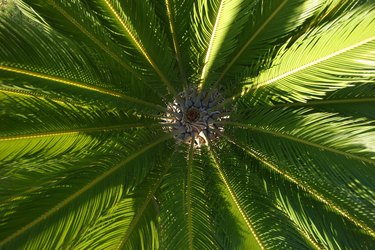
Dating to the time of dinosaurs, sago palm (Cycas revoluta) often is called a living fossil. Although it is not a palm, it shares similar climactic requirements with palms and can be damaged easily by frost and freezing weather when grown on the margins of its hardiness zones, advises Texas A&M System AgriLife Extension. Care of a frost-damaged plant is relatively straightforward, and preventive measures may help stave off sago palm freeze damage during subsequent cold weather.
Sago palm is hardy in U.S. Department of Agriculture (USDA) plant hardiness zones 9 and 10. Evidence also indicates it is hardy in protected areas of USDA zone 8, as shown by its common use in areas of north Florida and central Georgia to Texas. Even in those warm areas, however, cold snaps occur.
Video of the Day
Video of the Day
Care After a Freeze
A cold-damaged sago palm has yellowing or black mottling along the leaf blades, advises the University of Florida IFAS Extension. Once frozen or frosted, a leaf is permanently disfigured or lost and does not recover. A very hard freeze can damage the trunk, killing the entire plant.
Experts disagree whether cold-damaged sago palm leaves should be removed immediately or allowed to stay on the plant for a short time. Experts in favor of immediate removal state the damaged leaves draw resources necessary for the rest of the plant to survive, notes Walter Reeves.
Others disagree, stating damaged leaves should stay on the plant until all threat of frost passes, and that even discolored and dying leaves provide insulation for the plant's core. In either circumstance, the damaged leaves should be removed prior to the onset of new growth in spring.
Prevent Sago Palm Winter Damage
If you live in a northern extreme of USDA zone 8, monitor overnight lows forecast for your area during the volatile winter months. Although sago palm can survive brief exposure to 15 degrees Fahrenheit, it shows evidence of damage even from a temperature near the 30-degrees Fahrenheit mark.
If a low near or below 32 degrees Fahrenheit is forecast, consider covering your sago palm with a bed sheet, blanket or burlap. The covering should be removed during the day if the temperature is forecast to rise well beyond 32 degrees Fahrenheit, but the covering can stay on the plant even during daylight hours if the temperature stays low. A sago palm growing in a pot is simple to protect simply by moving it indoors for the duration of the cold threat.
Sago Palm Plant Facts
More closely related to conifers and another ancient species, sago palm is a type of cycad, thought to have evolved from fernlike plants prior to the Mesozoic Era more than 150 million years ago. It is extremely slow-growing, requiring 50 pr more years to reach its mature height of 10 to 12 feet.
Sago palm's primary distinguishing feature is its dark-green, needled leaf blades that arise from its shaggy central trunk. The leaves die back over time as the trunk grows taller. A sago palm is either male or female; only a male sago palm develops an upright, pale-yellow cone in its crown.